It’s been established that unequal distribution of physicians contributes to overall healthcare disparities between urban and rural communities. Now, researchers at Brigham and Women’s Hospital have demonstrated the same is true for orthopedic trauma outcomes.
They found that, as in medicine generally, orthopedic trauma outcomes in urban areas are more closely correlated with socioeconomic status than outcomes in rural areas are. Hannah M. Thomas, of Harvard Medical School, Arvind von Keudell, MD, MPH, director of Geriatric Orthopaedic Trauma Surgery and Research in the Department of Orthopaedic Surgery at the Brigham, and colleagues report the findings in Injury.
Methods
The data source for this retrospective study was the Nationwide Inpatient Sample, a nationally representative sample of U.S. inpatients. The researchers identified 235,393 patients diagnosed with a hip or long bone fracture in 2016 or 2017. When weighting was applied, they represented 1,176,965 patients nationally.
18% of the cohort was classified as rural. There were 118,120 hip fractures (50%), 86,321 long bone fractures (37%), and 30,952 cases of polytrauma (13%).
Rural vs. Urban
Multivariable analysis showed:
- Patients with hip fracture—In-hospital mortality was 32% more likely for rural residents than urban residents (OR, 1.32; P<0.001), but there was no between-group disparity in complications
- Patients with long bone fracture—No significant difference in mortality or complications between urban and rural residents
- Patients with polytrauma—Same as for long bone fracture
Lower vs. Higher Income
Having a low income was defined as living in a zip code with household income below the national median. Its influence varied:
- Patients with hip fracture—No significant differences in complications or mortality between income groups
- Patients with long bone fracture—Low income was linked to significantly increased odds of complications compared with higher income, but the relative difference was small and not clinically significant (OR, 1.06; P=0.027); there was no significant difference between income groups in mortality
- Patients with polytrauma—Low income was associated with increased odds of mortality in urban patients (OR, 1.23; P=0.002) but not rural patients; low income was not associated with complications for either urban or rural patients
Implications for Clinicians and Policymakers
The presence of a geographic disparity in mortality for the hip fracture group but not the long bone or polytrauma groups suggests efforts to improve outcomes after orthopedic trauma should focus on the care pathway for hip fractures in rural residents.
The similar outcomes between urban and rural polytrauma patients may reflect limited opportunities to improve outcomes for these injuries. Similar outcomes in the long bone fracture group may indicate a low need for improvements.
The presence of socioeconomic-based disparities in the urban group but not the rural group supports previous conclusions that urban settings are more susceptible to healthcare segregation—low-income patients and patients of color are more likely to receive care at hospitals with relatively poor performance on quality measures.
Policymakers should therefore improve access to high-quality centers by improving insurance coverage and the resources of lower-performing centers that serve rural patients and disproportionally large populations of low-income patients and patients of color. Disparity-sensitive measures of access and quality could help identify organizations that need improvement.
